LANDING VEHICLE TRACKED (LVT) MAKES COMBAT DEBUT
Tarawa, Gilbert Islands • November 20, 1943
On this date in 1943 the Alligator LVT-1, or Landing Vehicle Tracked‑1, made its first combat debut. Actually, the LVT‑1 saw use in landings on Guadalcanal and the adjacent islands of Tulagi, Tanambogo, and Gavutu over a year earlier, in August 1942, but only as a logistical support vehicle carrying cargo and ammunition from mother ship to invasion beaches and evacuating the wounded on return trip. In combat on Tarawa on November 20, 1943, the LVT turned in a less than stellar performance in its new offensive role: over 70 percent of the amphibious vehicles were put out of commission on D‑Day.
The brainchild of Floridian inventor and philanthropist Donald Roebling, the LVT‑1 was known as an amtrac or amtrak by U.S. Marines for “amphibious tractor” and “Alligator” or “Gator” by Roebling. What Roebling built in his estate workshop in the mid- to late-1930s was an amphibious tractor intended for rescue work in the aftermath of Florida’s many devastating hurricanes. A 1937 article in LIFE magazine touting Roebling’s invention caught the attention of the Commandant of the U.S. Marine Corps. The Corps and parent Department of the Navy recognized the military potential of Roebling’s amphibious machine about the time war clouds began casting ominous shadows stretching from the Chinese mainland, where Japan was embroiled in a war it started in 1937, to the thousands of Pacific islands in Japan’s watery backyard. Japanese military leaders and ultra-nationalist statesmen were beginning to formulate a pan-Asian scheme—eventually morphing into the Greater East Asia Co-Prosperity Sphere—that would have their empire become the dominant player in an Asia-Pacific region that decades earlier had been parceled among British, French, Dutch, and American squatters.
In 1940 several more generations of the Alligator, each more powerful than its predecessor, were delivered and field-tested at Quantico, Virginia, and on the U.S. Caribbean island of Puerto Rico. The first military version, LVT‑1, was neither armor-plated nor armed. It was kludgy to drive. Deployed overseas in May 1942, it saw logistical support service during the Guadalcanal campaign (August 7, 1942, to February 9, 1943). Modified by the U.S. military to its own specifications, the larger and more powerful LVT‑2 Water Buffalo saw service at Bougainville (November 1943 to August 21, 1945). Manned by a crew of 6, it carried 24 fully equipped men or 4,600 pounds of cargo. The LVT‑4 Water Buffalo, finally furnished with a stern ramp to deploy troops, landed on Saipan on June 15, 1944. The LVT‑A4 armored amtrac mounted a 75mm howitzer and two Browning machine guns to add fire support for assault troops, seeing service on Saipan and on Guam and Tinian in July 1944. The formidable LVT‑3 Bushmaster, powered by two Cadillac V‑8 engines, faced down Japanese resistance on Okinawa in 1945.
Nearly 20,000 LVTs were produced and used by all branches of the armed services, including those of several other Allied nations, and in all theaters in World War II. They played their greatest role in securing the Pacific islands so strategically crucial to any invasion of the Japanese Home Islands, an invasion that was scrapped after two atomic bombs obliterated Hiroshima and Nagasaki on August 6 and 9, 1945, respectively. Shelled from sea and blasted from the air, in the end enemy-held Pacific islands had to be secured by ground forces who often had to wade long distances from their drop-off point to the landing beaches, circumvent intervening reefs and sandbars, all the while taking heavy fire from the well-hidden and well-protected Japanese bunkers and pillboxes. The ability of the tracked LVTs to deposit troops directly from ship to enemy shore went a long way in minimizing overall Allied casualties and shortening the Pacific War.
The LVT Amtrac Changed the Conduct of World War II Amphibious Warfare
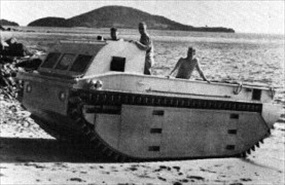 | 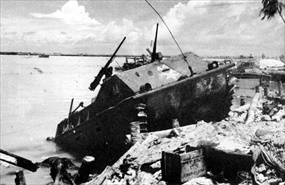 |
Left: A Landing Vehicle Tracked-1 (LVT-1) during its testing phase on the Caribbean island of Puerto Rico, 1940. Donald Roebling had conceived the Alligator, as he dubbed it, in 1935 to operate in swampy areas. At first resistant to a militarized version of his rescue vehicle, Roebling embraced the LVT‑1 after war broke out in Europe. Roebling delivered his first production LVT‑1 to the U.S. government in July 1941, 5 months before the U.S. was sucked into the war at Pearl Harbor, Hawaii. Two facilities in Florida and two in California delivered 18,616 LVTs to the U.S. Army, U.S. Marine Corps and to British and Australian armies.
![]()
Right: Disabled by enemy fire during the Battle of Tarawa, an LVT‑2 Water Buffalo sits awkwardly at a beach barricade on Red Beach 1. Of the 75 unarmed LVT‑1s and 50 armed LVT‑2s deployed at Tarawa, an atoll in the Gilbert Islands, only 35 were still operational at the end of the first day.
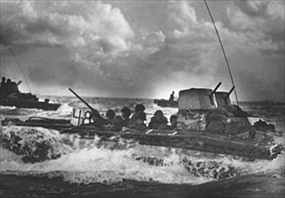 | 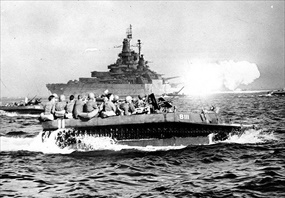 |
Left: Loaded with U.S. Marines an LVT‑4 Water Buffalo churns through the sea bound for the beaches of Tinian Island, in the Northern Marianas, July 1944.
![]()
Right: An LVT-4 Water Buffalo in the foreground carries U.S. troops to Okinawa’s invasion beaches, one of over 1000 LVTs that took part in the landings, while Pearl Harbor survivor battleship USS Tennessee bombards the island with her triple 14‑inch (356mm) main battery guns on April 1, 1945.
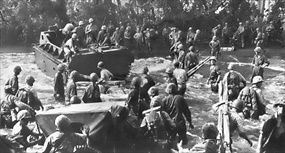 | 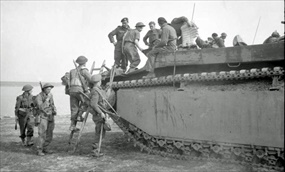 |
Left: Moving off the ramp of a Coast Guard-manned LVT, Marines move ashore on D‑Day at Cape Gloucester (also known as Tuluvu), December 26, 1943, during the Battle of New Britain.
![]()
Right: Royal Engineers with the British Second Army under Lt. Gen. Sir Miles Dempsey climb into an LVT‑4 Water Buffalo (British designation Buffalo IV), one of some 600 Buffaloes available to the British, during the Allies’ Lower Rhine crossing, March 23, 1945. Part of Operation Plunder, the amphibious assault into the heartland of Nazi Germany was at Rees, Wesel, and south of the river Lippe in the state of North Rhine-Westphalia.
U.S. Navy Documentary: A Talking LVT, Landing Vehicle Tracked
![]()

 History buffs, there is good news! The Daily Chronicles of World War II is now available as an ebook for $4.99 on Amazon.com. Containing a year’s worth of dated entries from this website, the ebook brings the story of this tumultuous era to life in a compelling, authoritative, and succinct manner. Featuring inventive navigation aids, the ebook enables readers to instantly move forward or backward by month and date to different dated entries. Simple and elegant! Click
History buffs, there is good news! The Daily Chronicles of World War II is now available as an ebook for $4.99 on Amazon.com. Containing a year’s worth of dated entries from this website, the ebook brings the story of this tumultuous era to life in a compelling, authoritative, and succinct manner. Featuring inventive navigation aids, the ebook enables readers to instantly move forward or backward by month and date to different dated entries. Simple and elegant! Click 











